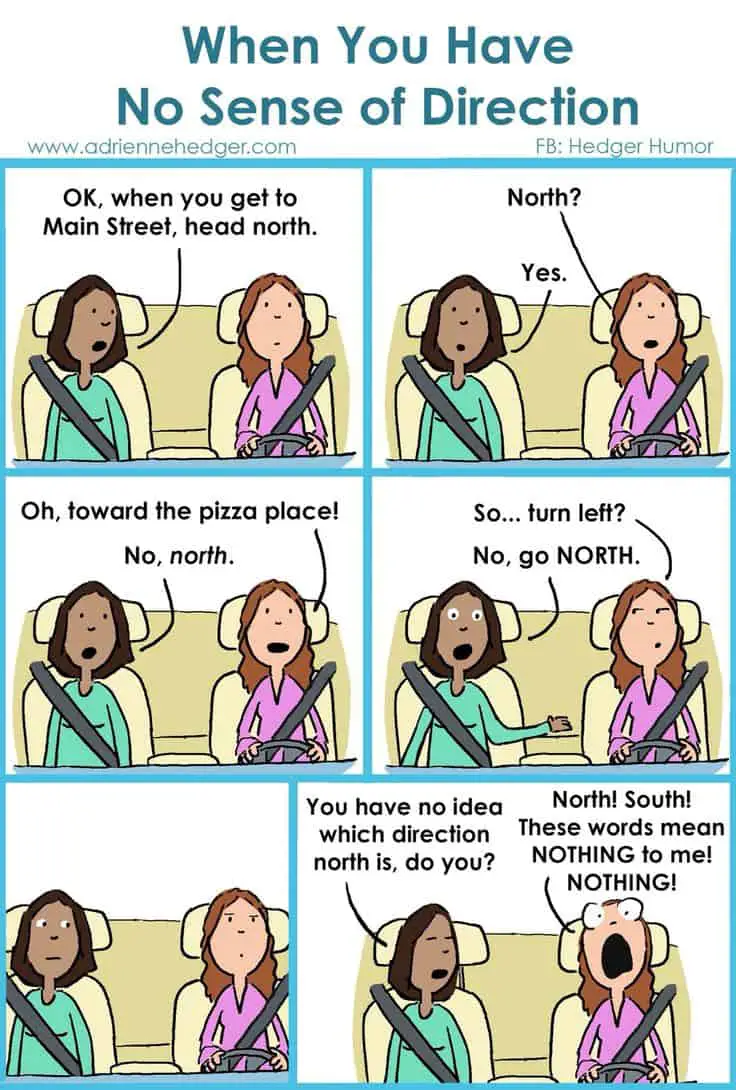I have a severe directional disability.
I’ve had some bad experiences lately. On one occasion, my gas tank was empty, my bladder was full and I was lost. Not a good combination. I can hardly describe the relief I felt after making a pit stop to take care of the urgent needs, then turning onto a familiar road that would take me home.
It’s causing me so much stress in my life, I’ve decided to analyze it, to see if I can figure out why I have so many problems and make some improvements.
Some relevant factors:
I don’t know which way is North and South.
I don’t know East and West if it’s night or mid-day.
I often confuse my Right and Left.
I get disoriented easily.
I have massive short term memory failure.
Brain fog. Yes, that’s a thing. It’s also a symptom of thyroid disease, so I’ll blame it on that.
I’m a slow learner.
I’m technically challenged.
I need to use reading glasses, which are not always close at hand.
I’m not used to my phone and don’t know how to operate it well.
I have trouble making decisions under pressure.
I drive a stick shift.
I don’t have a bird’s eye view of geography.
I don’t know which direction cities and towns are.
I don’t know where I live in relation to other cities and towns.
I don’t carry a map in the car.
I often forget to charge my phone.
When I print directions I forget to look up a return route.
I’m not used to using google maps on my phone.
After missing a turn or getting lost, turning around can be stressful.
I day dream a lot, especially in the car– riding or driving.
I’m not detail oriented.
I’m not observant. (Maybe one reason I love Sherlock so much.)
I have trouble with focus and concentration. My mind wanders faster than a two year old.
This is my life and it isn’t pretty.
Having broken down the components of the necessary skills, there’s some areas I can work on and improve.
Here’s what helps:
1. Doing my homework before I set out. This is key. Life is busy. It’s tempting to think “I’ll figure it out on the way.” Plus I’m preoccupied with what to wear, what snacks to throw in, what else do I need to bring, who do I need to communicate with and what’s the weather going to be like. (I do live in Indiana, after all.)
But, if I don’t take enough time to actually study and understand the directions before I leave, I’m setting myself up for a bad experience.
Also, it helps me to take a minute to be mindful about which direction different cities lie and which direction I’m heading.
I also need to plan a return route. When you’re severely directionally challenged, you can’t just re-trace your steps.
2. Two sets of directions. One printed from Maquest, plus Google Maps on my phone.
3. Make a cheat sheet. For me, this means a condensed version of the directions, with all the critical info written in large type.
4. Recharge the phone in the car. Easy fix.
5. Focus and concentrate at the critical junctures. During a one hour trip, for insistence, there might be only twenty minutes when concentration is necessary and 40 minutes of smooth sailing. It’s not necessary to be on hyper alert the whole time.
If you never have a problem getting where you need to go, more power to you!
And three cheers for any analysis that makes life better.


